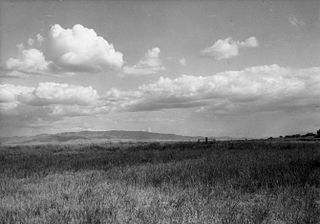
Fort Hall was a fort that was built in 1834 as a fur trading post by Nathaniel Jarvis Wyeth. It was located on the Snake River in the eastern Oregon Country, now part of present-day Bannock County in southeastern Idaho, United States. Wyeth was an inventor and businessman from Boston, Massachusetts, who also founded a post at Fort William, in present-day Portland, Oregon, as part of a plan for a new trading and fisheries company. Unable to compete with the powerful British Hudson's Bay Company, based at Fort Vancouver, in 1837 Wyeth sold both posts to it. Great Britain and the United States both operated in the Oregon Country in these years.
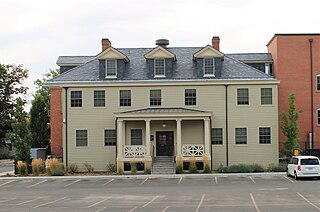
Fort Boise is either of two different locations in the western United States, both in southwestern Idaho. The first was a Hudson's Bay Company (HBC) trading post near the Snake River on what is now the Oregon border, dating from the era when Idaho was included in the British fur company's Columbia District. After several rebuilds, the fort was ultimately abandoned in 1854, after it had become part of United States territory following settlement in 1846 of the northern boundary dispute.
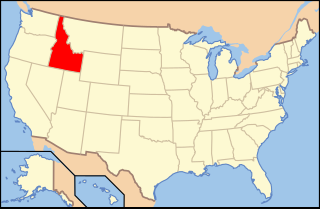
The following is an alphabetical list of articles related to the U.S. state of Idaho.

The following outline is provided as an overview of and topical guide to the U.S. state of Idaho:

Cathedral of the Rockies, also known as the Cathedral of the Rockies First United Methodist Church, is a United Methodist church located in the historic North End district of Boise, Idaho, United States. The church is the largest United Methodist Church in Boise, Idaho, the largest in the Oregon-Idaho Conference of the United Methodist denomination, and was the first Methodist church in Boise, founded in 1872.
Oregon Trail Historic District may refer to:

The Capitol Boulevard Memorial Bridge, also known as the Oregon Trail Memorial Bridge, is a historic bridge over the Boise River in Boise, Idaho, United States, the is listed on the National Register of Historic Places.

The John A. O'Farrell Cabin was built by John A. O'Farrell in Boise, Idaho, in 1863. The cabin is considered the first family home in Boise.
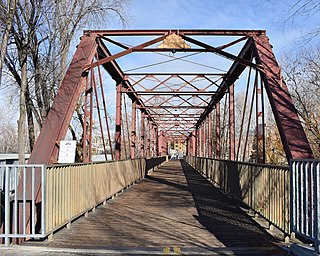
The Ninth Street Bridge in Boise, Idaho, also known as the Eighth Street Bridge, crosses the Boise River and is a 2-span, pin-connected Pratt through truss design constructed by the Missouri Valley Bridge & Iron Co. and completed in 1911. Each span is 160 ft (49 m) and includes six full panels and two end panels, supported by concrete piers at each end and midway in the river. Laced channel sections with cover plates form the upper chords, with eyebars on the lower chords. Eyebars with turnbuckles form the diagonals. The bridge was added to the National Register of Historic Places in 2001.

The Union Block and Montandon Buildings in Boise, Idaho, are 2-story commercial buildings with rustic sandstone facades. The Romanesque Revival Union Block was designed by John E. Tourtellotte and constructed in 1901, and the Renaissance Revival Montandon Building was designed by J.W. Smith and constructed in 1908. Also known as the Fidelity-Union Block, the buildings were added to the National Register of Historic Places (NRHP) in 1979.

The Idaho National Guard Armory in Boise, Idaho, is an unreinforced, poured concrete building designed by Tourtellotte & Hummel and constructed in three phases beginning with a 1-story section in 1931. The building includes a drill hall large enough for equestrian events and a 2-story office area completed in 1956. The facade is minimally decorated and features Art Deco elements, including a cornice of stepped concrete bands, projecting pilasters, and zigzag patterning.

Lowell School in Boise, Idaho, is a 2+1⁄2-story, brick and stone elementary school constructed in 1913 and named for James Russell Lowell. The building was expanded in 1916, 1926, and 1948, and it was added to the National Register of Historic Places (NRHP) in 1982.

The Mitchell Hotel in Boise, Idaho, was a 2-story, brick and stone building designed by Tourtellotte & Co. and constructed in 1906. The building featured segmentally arched fenestrations with "denticulated surrounds of header brick." The building was listed on the National Register of Historic Places (NRHP) in 1982.

The Adolph Schreiber House is a 2-story, Neoclassical Revival house in Boise, Idaho designed by Tourtellotte & Hummel and constructed by contractor O.W. Allen in 1915. The design included a 10-room dwelling and a second-story apartment accessed from a side entrance. The house was added to the National Register of Historic Places (NRHP) in 1982.

The C.C. Cavanah House in Boise, Idaho, is a 2-story Colonial Revival structure designed by Tourtellotte & Co. and built by W.D. Stevens in 1906 for Charles Cavanah. The house was added to the National Register of Historic Places (NRHP) in 1982.

The W. E. Jefferson House in Boise, Idaho, is a 1+1⁄2-story Queen Anne, Shingle style cottage designed by Tourtellotte & Co. and constructed in 1907 in Boise's Hyde Park neighborhood. The house features front, right, and left gabled dormers and a cross-facade porch supported by square coffered posts. The house was added to the National Register of Historic Places (NRHP) in 1982.
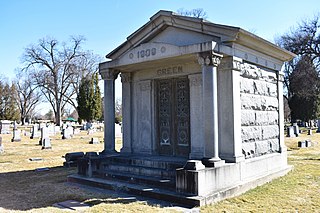
The John Green Mausoleum at Morris Hill Cemetery in Boise, Idaho, is an eclectic entombment designed by Tourtellotte & Co. and constructed in 1909. The mausoleum is made of stone and shows a Romanesque influence with geometric forms. Bronze doors opposite a single window are the only fenestrations, and corner pilasters frame the structure. A parapet stairway extends beyond an outset gable above the entrance. The mausoleum was added to the National Register of Historic Places in 1982.

The Albert Beck House in Boise, Idaho, is a 1+1⁄2-story Queen Anne house designed by Tourtellotte & Co. and constructed in 1904. The house features sandstone veneer on its first floor walls and on a wrap around porch. Overhanging gables with dimpled dormer vents were prominent at the Fort Street and 11th Street exposures. The house was added to the National Register of Historic Places in 1982.

Franklin School in Boise, Idaho, was a 2-story, brick and stucco building designed by Tourtellotte & Hummel and constructed in 1926. The school featured a flat roof with a decorated concrete parapet. The school was added to the National Register of Historic Places (NRHP) in 1982. In 2009 the building was demolished.




















